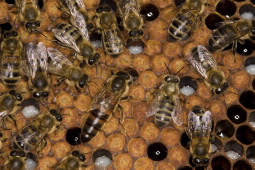FOR IMMEDIATE RELEASE
ACS News Service Weekly PressPac: July 18, 2012
Enhanced royal jelly produces jumbo queen bee larvae
“Growth Stimulating Effect on Queen Bee Larvae of Histone Deacetylase Inhibitors”
Journal of Agricultural and Food Chemistry
Scientists have discovered a way to make worker bees produce an enhanced version of royal jelly (RJ) – the super-nutritious substance that dictates whether larvae become workers or queens, and that is also renowned as a health supplement for people. Their study, which found that the super RJ that makes queen bee larvae grow 2-3 times larger than normal, appears in ACS’ Journal of Agricultural and Food Chemistry.
Chia-Nan Chen and colleagues explain that royal jelly is a thick liquid made up of proteins, sugars and fats that is secreted by glands in the throats and jaws of worker bees and fed to larvae. Workers feed all bee larvae RJ for the first three days of their lives, but only the queen gets it throughout life, growing larger and living up to 15 times longer than other bees. The scientists treated worker bees with drugs called histone deacetylase inhibitors (HDACis) to see whether they could enhance the larvae’s growth.
They found that worker bees given HDACis produced a fortified royal jelly that made the queen bee larvae grow to be 2-3 times larger than larvae fed standard royal jelly. A couple HDACis have already been approved for treating certain forms of cancer. The scientists noted that this is the first study showing that the composition of RJ can be modified in a way that changes the body size of queen bees during development.
The authors acknowledge funding from the Small Business Innovation Research (SBIR) grant (SBIR, 1Z-960165) from the Ministry of Economic Affairs, Taiwan (Province of China).
![]()
Contact
Science Inquiries: Michael Woods, Editor, 202-872-6293
General Inquiries: Michael Bernstein, 202-872-6042


